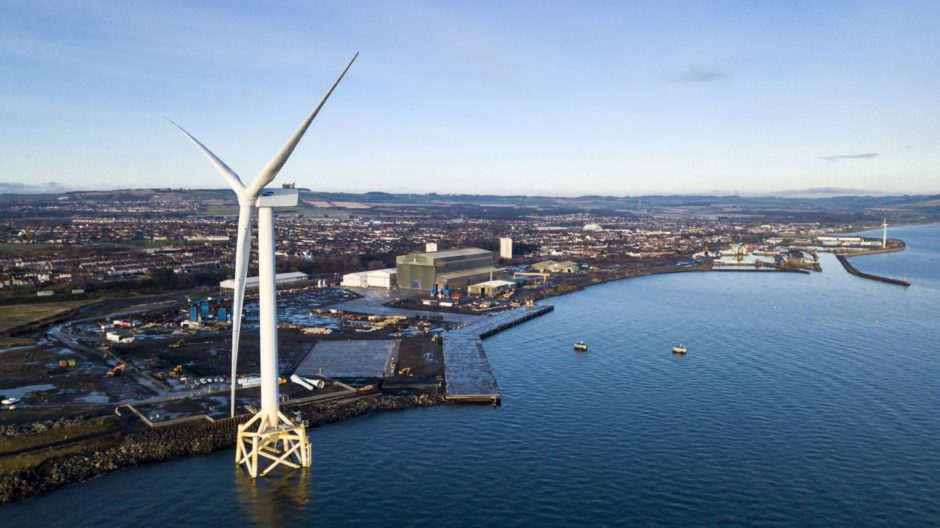
Heeding past mistakes on offshore wind is key for policymakers seeking to build up the burgeoning hydrogen industry in Scotland, according to Xodus Group.
The Aberdeen-headquartered consultancy has been advising the Scottish Government on its hydrogen policy, specifically green hydrogen from offshore wind, producing a paper on the topic in December.
Renewables division manager, Scott Hamilton, said: “When it comes to hydrogen, one of the things I’m keen on is making sure that we look at the past experience of the offshore wind industry and make sure that we don’t make some of the mistakes around that process.
“If we are looking for industrialisation and we are looking to start making some of these things, then let’s not just walk blindly into making the same mistakes that went previously. Let’s look at how we build a process and a policy framework that actually encourages that to happen.”
Scotland has not been a stranger to false dawns on new industry before, particularly offshore wind where jobs promises have fallen short and lucrative manufacturing work has gone overseas in the main.
In 2019, it was revealed that, despite the Scottish Government’s 2010 prediction of 30,000 direct jobs in offshore wind by the end of the last decade, there were around 1,900 (direct) by the end of 2019.
Earlier this year, the Offshore Wind Industry Council said direct and indirect jobs UK-wide stood at 26,000.
Meanwhile, as firms like Xodus look at the impact of hydrogen as it compares to offshore wind, Scottish Renewables has dished out the sizeable estimate of 310,000 green hydrogen jobs across the country by 2045, with £25bn of gross value added.
Xodus has not issued any such jobs estimates or GVA figures in its report, “because they can be very dangerous numbers to play with”, according to senior field development study manager Graham Barton.
He said: “They only work with a certain policy framework around them. And if that’s not there, you can get some very disappointed people.”
However, getting the best policies in place can create a supply chain around hydrogen with industrialisation, according to division manager Scott Hamilton, possibly even “making up for what we’ve lost out on over the past 20 years”.
Unlocking the economic opportunity of green hydrogen, produced via renewables, for heat and transport will require a “decade of serious action” according to Xodus, with policy being the first step.
Scotland has a “whole bunch of natural advantages”, including seabed space, strong winds and pipelines for exports, but the demand-side is what’s currently lacking.
Taking the LNG model in Africa, whereby exports come first and then, during downtime, investment is made in domestic infrastructure, could be the answer.
Hamilton said: “That model would work really well for hydrogen, and if we take that process through, there is no reason why we couldn’t have the associated supply chain jobs as well.
“But the lessons learned from offshore wind say that you need to make the deliberate point of deciding on that process first.”
In offshore wind, he pointed to a period of a year to 18 months when there was “too much risk in the market”, between the handover of policies.

The lack of local content in the Renewables Obligation scheme, which closed in 2017, and uncertainty surrounding the transition to Contracts for Difference price guarantees meant manufacturers chose not to invest and instead went overseas.
“It was that uncertainty in the handover of the processes because there wasn’t one designed policy network of one leading to the next”, he said.
“So if we want to do this in the UK and want to get the real opportunity for hydrogen in Scotland, what we need to do is show that handover.
“Here will be the higher level of subsidy support or whatever we decide to do first, to encourage the manufacturing, the investment to come here in the first instance. Once we’ve achieved that, where we’ve set some KPIs, then we’ll hand over to the next policy framework which is designed to drive down costs.
“It’s that idea of deciding first-hand what do you want. If all you want is cheap hydrogen, then let’s go straight to a CfD-type process. Don’t do that and then go ‘where are all the jobs?’ If you want jobs then invest into that process, and then look to bring down the cost of green hydrogen.”
Mass manufacturing of floating wind foundations could be part of the vision, Hamilton said, and the Scotwind leasing round in the coming months could ultimately be “strongly linked” to a needed pipeline of projects.
However, with manufacturing limitations at present, small, demonstrator “stepping stone” developments in Scotland between now and Scotwind is “the key to success in both getting this technology and the costs right, as well as the supply chain opportunity”.
Hamilton said: “Most of these will be floating wind technology so we can take advantage of the opportunity to disrupt the established supply chain relationships.
“You know, nobody makes floating wind foundations at scale. Therefore somebody needs to put their flag in the sand and really just get after this opportunity with demo sites of the right type.”
‘I’ve seen a region decimated when oil and gas pulls out’
Green hydrogen won’t become commercial until 2032, according to Xodus’ estimates, so some kind of incentive, be it a CfD-type policy or other market-correction will be needed to get private sector investment on board to build that pipeline of projects.
Graham Barton, a former oil and gas engineer who spent 20 years with Shell, sees the industry’s skills as a means to transition.
But, aside from the net zero push, he also sees the industry as a timely reminder of the urgency for a transition.
He said: “Part of my oil journey, “I was in Lowestoft in 2003, when Shell pulled out. We’ve got family down there. I’ve seen a region decimated when oil and gas pulls out.
We used to make platforms there. We used to do the whole supply chain thing and it still galls me when we see jackets being floated into the southern North Sea from Dubai and places like that.
“You think: ‘Come on guys, this mustn’t happen again in Scotland, this mustn’t happen as we transition into wind and hydrogen’.”
Scotland’s pipeline infrastructure from oil and gas is another string in its bow for hydrogen, however, Barton highlighted that the extent to which it is utilised remains up for discussion.
He suggested that, in the long-term, building a new (expensive) pipeline from Scotland to Germany could prove the “backbone” of the hydrogen economy.
“That’s the infrastructure investment and then you’ve got the European hydrogen backbone from Scotland and you can feed it in”, he said.
“So I must admit personally, brownfield and repurposing sounds very attractive, (but) having done lots of brownfield projects and lots of repurposing work, I wonder if it’s a false economy.
“I wonder whether actually it’s not so expensive in the long term to make that primary investment in new infrastructure for the next 50 – 100 years, rather than clinging on to some lines that are already 50 years old.”


